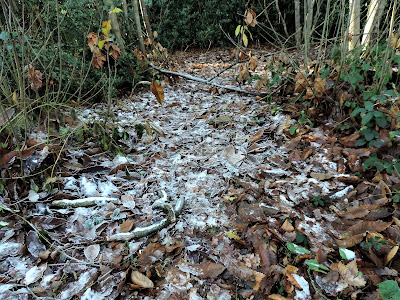At Christmas in 2017 I came across this photograph which I had
taken nearly ten years previously on 4 April 2008. I had forgotten that I was ever there and
would not have remembered where it was had I not been able to find details of
my visit buried in my computer. At first,
I had no idea about when or why I had taken the picture, but I gathered
fragmented recollections after a while.
The picture was taken looking east from an abandoned depot
or lorry park called Rosebank beside the A22 just north of Polegate in East
Sussex. The fields run down to the
Glynleigh Levels, a western branch of the larger Pevensey Levels, and the distant
horizon is where the village of Hankham lies on a spur of higher land projecting
northwards into the levels. In the past it was spelt 'Handcombe' and was part of a 'Limb of the Cinque Port Liberty of Hastings'. In the
mid-distance the dark, straight hedge marks the line of the Cuckoo Trail, a
cycle and pedestrian path along an abandoned track of the London-Brighton South Coast Railway.
This is a Low Weald landscape with little to excite the
imagination: fields and trees (with a tree house), a Shetland pony, various
fences and, on the left, a water-filled clay pit dug when the long-closed
brickworks nearby was active. Perhaps the
significance of the scene is that it would not win any prizes, would not
embellish the wall of a gallery or the page of a magazine. Its
somewhat nondescript virtues do, perhaps, have a Low Weald feel.
It is also represents only a fragment of time. The camera shutter was open for maybe 100th of a second and that exact scene will never return. It might be possible to go back to the site and frame a similar picture, but it would not be the same. The pony would have gone, the tree house might not be there and the trees and fences would have changed. And who knows what alteration might come over centuries and millennia?
It is also represents only a fragment of time. The camera shutter was open for maybe 100th of a second and that exact scene will never return. It might be possible to go back to the site and frame a similar picture, but it would not be the same. The pony would have gone, the tree house might not be there and the trees and fences would have changed. And who knows what alteration might come over centuries and millennia?
The picture reminds me too of the huge volume of data that lies
locked up in our brains because there is no reason or no one to open the
door. I have posted the picture in ‘the
Cloud’, so others may look at it for one reason or another, but they will not
have the memories I had of the afternoon I spent alone in that forgotten depot,
recording the flora and fauna and its ecological significance for a proposed
development. As Virgil said sunt lacrimae rerum et mentem mortalia tangunt (there are tears in things and life’s transience
moves the mind).





















